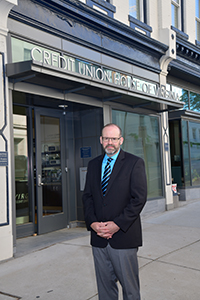Blurred lines?
Banks accuse credit unions of unfairly encroaching on their territory
Carol Hazard //July 29, 2020//
Blurred lines?
Banks accuse credit unions of unfairly encroaching on their territory
Carol Hazard //July 29, 2020//
The battle between banks and credit unions is flaring up again and it could wind up before the Supreme Court of Virginia.
Bankers say nonprofit credit unions are morphing into roles that look like traditional banks, becoming larger than many community banks while facing lighter tax and regulatory burdens, giving the credit unions an unfair advantage.
However, credit unions are pushing back, saying they are chartered as member-owned, tax-exempt, not-for-profit organizations for the purpose of helping members build savings and access affordable credit.
“That was true in 1934 when the Federal Credit Union Act became law and it is true today,” says Lewis Wood, spokesman for the Virginia Credit Union League.
Bruce Whitehurst, president and CEO of the Virginia Bankers Association, disagrees. Large, growing credit unions should be on the same regulatory playing field as banks, he says.
The battle has roiled since 1998, ever since Congress loosened restrictions on credit unions, giving them more latitude to expand their membership circles and charters.
Potential landmark case
Take, for example, a dispute brewing for a year between Virginia Credit Union and bankers (seven community banks and the Virginia Bankers Association) over Virginia Credit Union’s plans to extend membership to the Medical Society of Virginia’s 10,000 members and their families — well beyond Virginia’s statutory limit of 3,000 new credit union members at a time.
The State Corporation Commission held a virtual hearing on the matter July 9 and 10. The examiner will make a recommendation to the commission, but a decision is not likely until late this year.
The dispute could eventually end up being appealed to the Supreme Court of Virginia, where it may prove to be a landmark case in determining whether any boundaries exist on the expansionary powers of large credit unions.
Virginia Credit Union says the Medical Society of Virginia approached the credit union about joining.
“As it is a pending matter, we cannot offer extensive comment,” said Glenn Birch, spokesman with the Virginia Credit Union. “We believe the approval decision reached last year by … the Bureau of Financial Institutions was appropriate and justified.”
Wood says the bureau made the right decision in allowing members of the society the option to join Virginia Credit Union, since it was “not practical, nor likely viable, for the society to form a separately chartered [credit] union.”
Bankers say the attempt to sweep in a 10,000-member organization under the argument that they are underserved is preposterous.
Virginia Credit Union’s website says “it’s easier than ever to join.”
The credit union was originally intended for state employees, but its charter was expanded over the years to include county and city employees, companies, organizations, students attending state-supported higher-education schools and people who live, work or attend school in the cities of Fredericksburg, Hopewell, Petersburg and Richmond; the counties of Buckingham, Cumberland, Nottoway and Prince Edward; and the town of Farmville.
“Simply offering what our members need and want is how we grow,” says Christopher Saneda, senior executive vice president and chief operations officer at Virginia Credit Union. “Our largest source of new members comes from referrals to family and friends.”

Association President and CEO Bruce Whitehurst.
Whitehurst says bluntly, “The credit union industry is two industries. Thousands of small credit unions have single common bonds and operate as they were intended when given the tax exemption in the 1930s,” he says. However, “a smaller group of large credit unions are multibillion-dollar institutions — the functional equivalent of banks — and they are accessed through multiple common bonds or community charters where members live, work or worship.”
BayPort Credit Union in Newport News, for example, originally offered membership to employees of Newport News Shipbuilding, but now anyone who lives in the area can join.
Or take University of Virginia Community Credit Union. “It now extends way beyond U.Va. employees,” Whitehurst says.
On the national level, the second-largest credit union in Michigan bought a community bank in Southwest Florida in 2018 and now anyone in Florida can become a member of Lake Michigan Credit Union.
“Multibillion-dollar credit unions with multiple ways to join is not the way they were intended and that is where you get into what’s broken,” Whitehurst says. “It’s a significant public policy question that from our perspective needs to be addressed.”
Different rules, same game?
Credit unions are exempt from paying federal income taxes and most state income taxes, but they do pay real estate taxes, personal property taxes and payroll taxes.
Banks pay all the above, including federal and state income taxes.
The exemptions were granted in 1937 with the understanding that credit unions would provide financial services to people of modest means sharing a common bond through an employer, church, school or community.
The Credit Union Membership Act of 1998 gave federal credit unions the authorization to expand beyond single common bonds to have multiple common bonds. The Virginia Credit Union Act of 2006 gave state-chartered credit unions powers comparable to federal credit unions.
Credits unions probably would not have survived without the changes to membership eligibility, says Wood with the 92-member credit union trade group.

Credit unions needed new ways to grow and diversify, he says.
Wood says neither the asset size of credit unions nor their membership base should be a consideration with respect to the tax exemption. “Our structure and mission are the reason for our tax status,” he says.
Bankers claim they are more heavily regulated than credit unions. What’s more, credit unions are not subject to the Community Reinvestment Act, requiring banks to lend to all segments in their communities, including low- and moderate-income neighborhoods.
The CRA was imposed on banks in 1977 because they were found to engage in discriminatory “redlining” practices, Wood says.
“Credit unions are structured to be self-regulating in that they exist only to serve the needs of members, “without regard to where they fall on the economic spectrum,” Wood says.
From a regulatory perspective, it’s misleading for banks to assert that credit unions are treated differently, Wood says. “All federally insured depositories are heavily regulated, including credit unions and banks.”
Toe to toe
The United States has more than 5,200 federally insured credit unions, including at least 315 with assets of more than $1 billion, according to the National Credit Union Administration.
Virginia is home to 116 credit unions, including two of the country’s largest — Navy Federal Credit Union ($112 billion in assets, 9 million members) and Pentagon Federal Credit Union, widely known as PenFed ($24.8 billion in assets, 1.9 million members).
The next largest is Virginia Credit Union, the largest state-chartered credit union in Virginia, with $3.7 billion in assets and 300,000 members.
A total of 70 banks are based in Virginia, including 64 community banks — defined as financial institutions typically locally owned and operated, with a focus on local businesses and families.
The issue of credit unions acting like banks is a concern to the entire banking industry, says John Asbury, president and CEO of Atlantic Union Bankshares Corp., parent company of Atlantic Union, the largest independent bank in Virginia.
“If you act like a bank, you should be taxed like a bank and be regulated like a bank,” says Asbury, also chairman of the Virginia Bankers Association.
Jim Eads, CEO of The United Methodist Credit Union in Henrico County — a single, common-bond credit union with only 3,000 members — says he can’t speak about large credit unions, “the 800-pound gorilla in the room.”
However, as a former banker, he understands why banks would be frustrated. “Large credit unions try to make themselves look like banks because that is who they are competing with,” Eads says.
Large credit unions offer similar retail financial products, but banks have the edge on commercial products, he says.
Eads says his credit union provides financial products that for-profit banks wouldn’t touch, such as “super low rate” interest on educational loans to United Methodist students or to students attending United Methodist colleges.
Wake-up call?
The dispute centers on big credit unions and community and/or regional banks, not large national banks.
Megabanks are not nearly as focused as community banks on low- to moderate-income consumers, which was the credit unions’ original mission, says Steve Yeakel, president and CEO of the Virginia Association of Community Banks.
Another core focus of community banking is small business lending, an area that “large, growth-obsessed credit unions” are increasingly pursuing, he says.
“Large credit unions have strayed from their limited mission and are blurring the lines between [credit unions] and full-service community banks,” Yeakel says. “Our concern is whether the latitude given to credit unions is being abused.”
The disparities are highlighted in the “Wake Up” advertising campaign sponsored by the Independent Community Bankers of America (ICBA), calling on policymakers and the public to “wake up” to what it calls “risky practices, costly tax subsidies and irresponsibly lax oversight of the nation’s credit unions.”
The ICBA claims tax exemptions allowed U.S. credit unions to avoid paying $2.8 billion in federal income taxes in 2018.
In Virginia, credit unions avoided paying $409.2 million in federal income taxes, money that could have been used to pay for 3,338 teachers, 2,399 police officers or 2,341 social workers, the ICBA contends.
Removing tax dollars that could be used to serve the needs of citizens is wrong, says Asbury. “At some point, the American taxpayer will figure out enough is enough.”
Nevertheless, Wood, with the Virginia Credit Union League, says, “Our calculations tell a different story. We estimate the credit union federal exemption ‘cost’ the government about $1.9 billion in revenue in 2019. However, credit unions delivered $18.9 billion in financial benefits to members and nonmembers in the form of better rates and fewer or reduced fees.”
The ICBA points to credit unions that have engaged in multimillion-dollar ad campaigns and naming-rights agreements, implying that such expenditures are unusual for nonprofits.
McLean-based PenFed launched a $50 million ad campaign in January in five states, Puerto Rico and Washington D.C., touting “great rates for everyone.”
In 2019, Chartway Federal Credit Union in Virginia Beach signed a $4.25 million, 10-year agreement with Old Dominion University for naming rights to an arena in the Ted Constant Convocation Center complex.
Vienna-based Navy Federal Credit Union invested $100 million in 2017 to expand an operations center in Winchester and announced plans then to expand from 6.5 million members to 10 million.
Bankers say such deals should invite scrutiny from lawmakers.
But again, credit unions disagree, saying nothing prevents them from marketing or brand building.
Naming-rights partnerships, they say, can be a more effective way to retain members and reach potential members than sending yet another mailer or producing another ad.
Subscribe to Virginia Business.
e

















